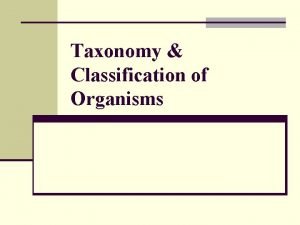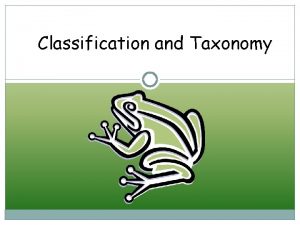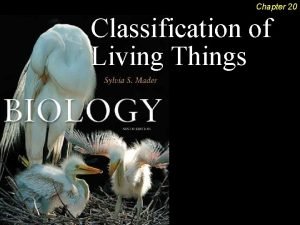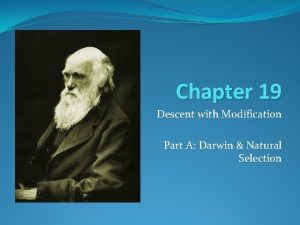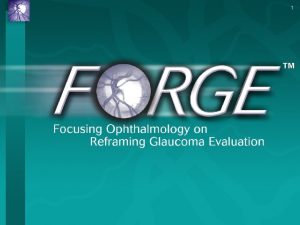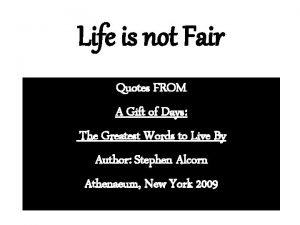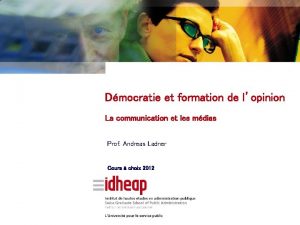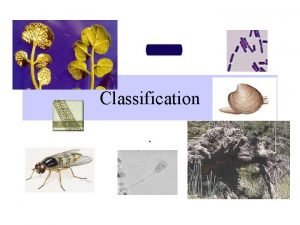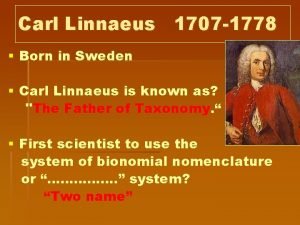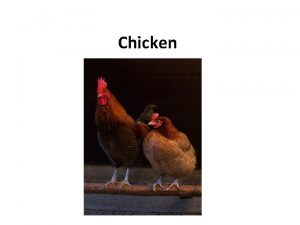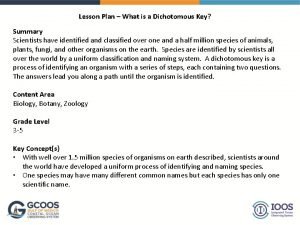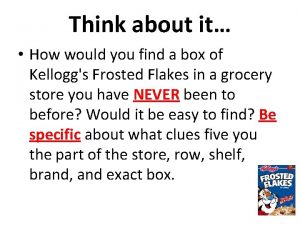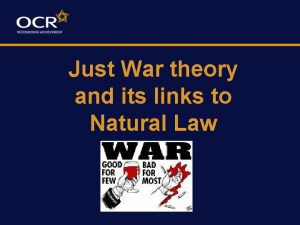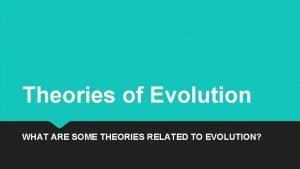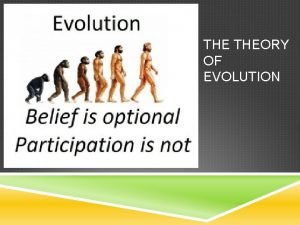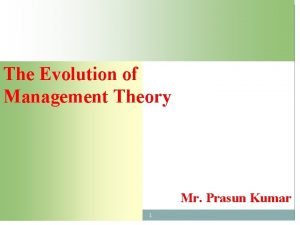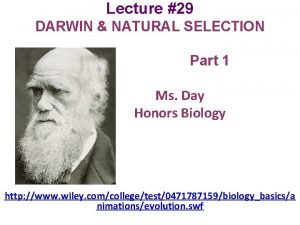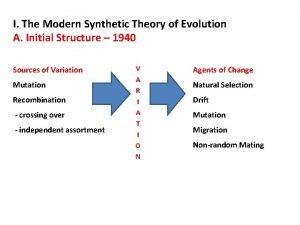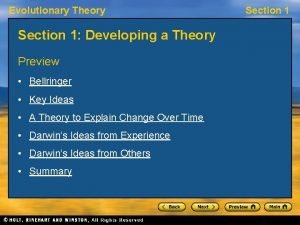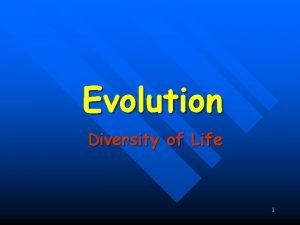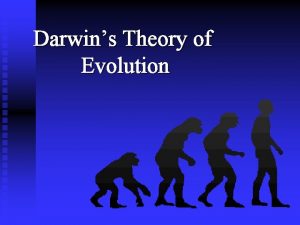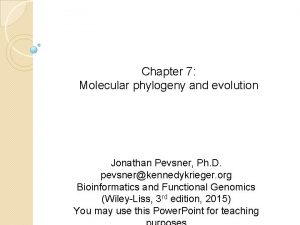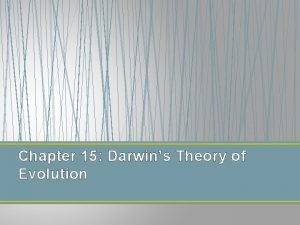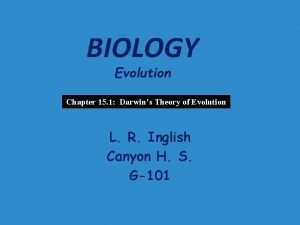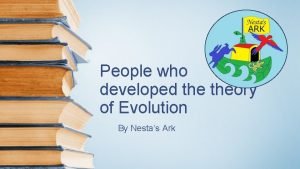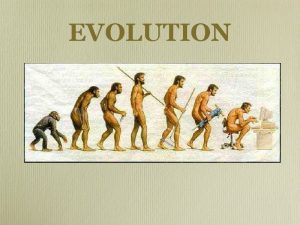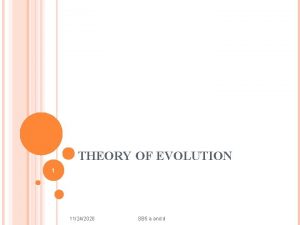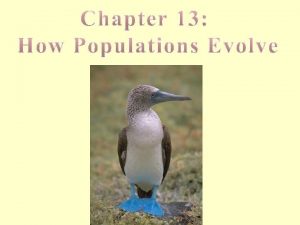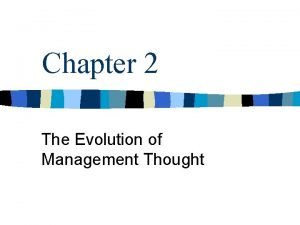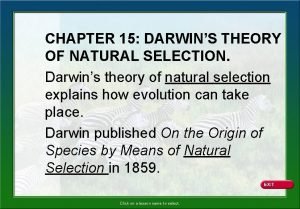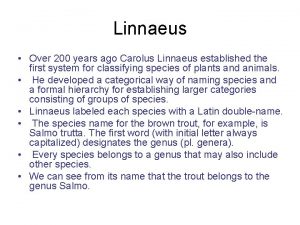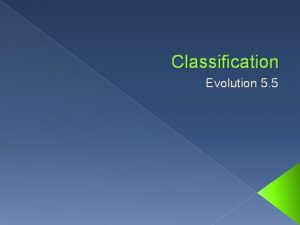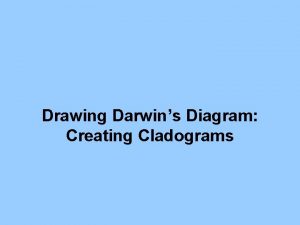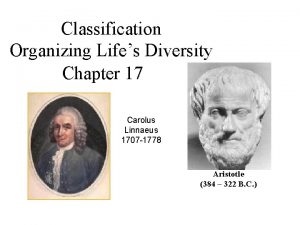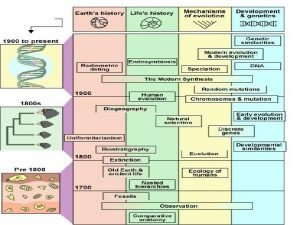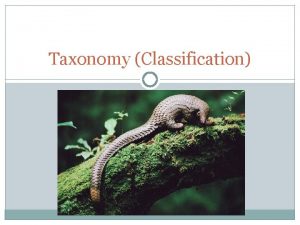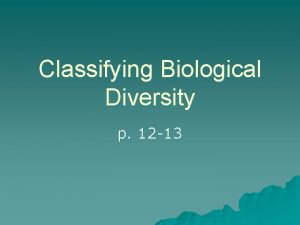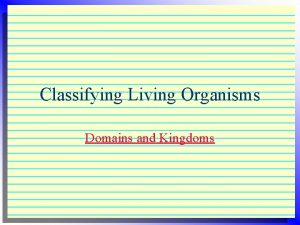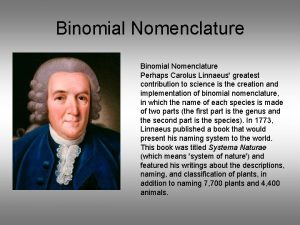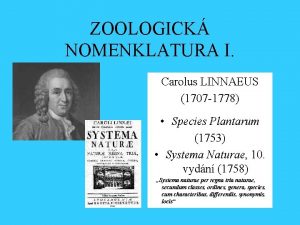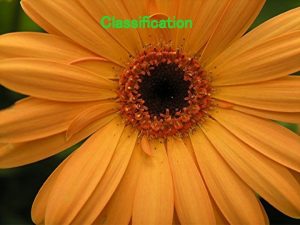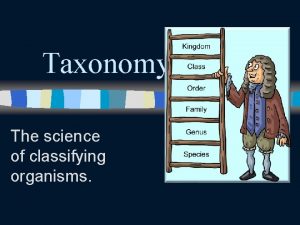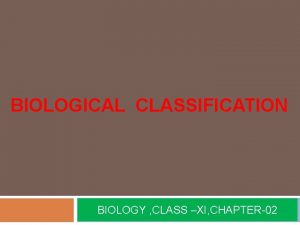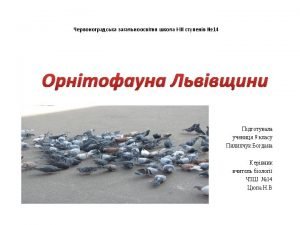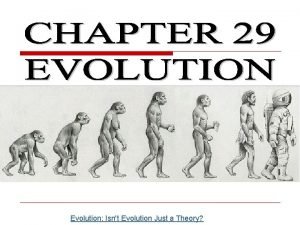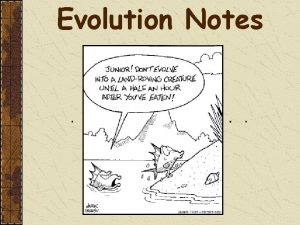Evolution Isnt Evolution Just a Theory Carolus Linnaeus













































- Slides: 45

Evolution: Isn't Evolution Just a Theory?

Carolus Linnaeus, 1735 ________ 2 nd to classify organisms based on traits their _____ Georges Buffon, 1749 ________ Erasmus Darwin, 1749 Jean-Baptiste Lamarck, 1809 _______________ Proposed that species shared ancestors ________ Proposed that more complex life forms less arose from _______ complex life forms Proposed that changes in an environment caused changes in organisms ________

CATASTROPHISM GRADUALISM UNIFORMITARIANISM

CATASTROPHISM Georges Cuvier Theory proposed by ____________. Natural disasters States that _______________ such as ______ and floods volcanic eruptions ________________ have landforms shaped ________ and caused species to become __________ in the process. extinct GRADUALISM James Hutton Theory proposed by ___________. States that the changes in landfoms resulted from slow changes __________ that had occurred over a long period of time. UNIFORMITARIANISM Theory proposed by ___________. Charles Lyell States that the changes in geologic processes that shape the Earth are uniform through time. The changes have happened in the past and _____________________ are ONGOING! _____________________

TYPES OF FEET WEBBED CLAWED PADDED HOOVED TYPES OF BEAKS FISH NUTS INSECTS FISH


COLORATION BODY FAT AND THICK FUR SPECIAL CHARACTERISTICS ADAPTATION ACTIVITY


1. It survives ________ 2. It passes on his traits ____________

1. It survives ________ 2. It passes on its traits ____________

_______________ Principles of NS __________ Natural Selection-- ___________________ process in which something in nature does the selecting of what will survive and ______________________________ what will not survive. ______________________________

PREDATORS ______________ WEATHER CONDITIONS _____________________ RESOURCE SHORTAGES ________________________ DISEASE ______________







Adaptations = traits _______________ Traits = genes _______________ Adaptations = genes _______________

1. A CHANGE IN THE DNA CODE _________________ 2. ARE NATURAL EVENTS ____________________ 3. CAN BE A SOURCE FOR NEW TRAITS ______________________________________________________ 4. THESE NEW TRAITS CAN BE ADAPTATIONS BECAUSE THEY MIGHT HELP THE ORGANISM ___________________________ SURVIVE IN ITS ENVIRONMENT ___________________________

BROWN COAT TO WHITE COAT __________________ The white deer is more easily seen by predators. It will most likely not survive and reproduce. The brown rabbit is more easily seen by predators. It will most likely not survive and reproduce.

Species – A group of living things that can breed ____________________________ with others of the same species and ____________________________ form ‘FERTILE’ offspring. ____________________________ Fertile – being able to reproduce by ____________________ forming egg or sperm cells ____________________

New species are formed by: 1. Animals within the same species are_____ separated by a_____________ barrier, (water, mountains, etc). a. They_____ live apart for thousands of years with different living conditions. ___________ 2. ________ Natural selection takes place within the two separate regions. 3. Individuals with the desirable traits for their specific environment ___________ survive and reproduce. 4. Over time the two groups can become different species as they develop different adaptations. _____

1. Seed Eaters 2. Plant Eaters 3. Insect Eaters 4. Cactus Eaters



HUMANS COME FROM MONKEYS

NEW WORLD MONKEYS OLD WORLD MONKEYS • Have tails • Some have tails • Nostrils Point Upwards • Nostrils Point Downwards Hamadryas baboon (Africa) Prehensile tails (spider monkeys) Howler Monkey Patas monkey (Africa) APES • No tails Congo Gorilla

PRIMATE EVOLUTION “Before Monkey” PROSIMIANS NEW WORLD MONKEYS OLD WORLD MONKEYS APES HUMANS 40 MILLION 30 MILLION 10 MILLION

APES AUSTRALOPITHECUS HOMO HABILIS Walked upright, very short. “Lucy” ___________________ Used tools, somewhat taller. Lived in Africa ___________________ HOMO ERECTUS ___________________ Lived in Europe. Continental drift? HOMO SAPIEN 10 MILLION YEARS AGO Neanderthal _________________ HOMO SAPIEN_____________ Cave Drawings, This is us! Ardi Did humans evolve?

What do the differences in the skull suggest? ____________________________ Virtual lab – Hominoid skulls Hominid Skulls

C Acurate measurements are taken to compare fossils. • A line is drawn over the eye socket from front to back of skull • A line is drawn under the eye socket from front to back of skull • A line is drawn from the highest point on the top of skull to lower line. B A Supraorbital index : Using a metric ruler, 1. Multiply the value of BC by 100 ____ 2. Divide the result by AC ____ Size of Brain / Intelligence What is the supraorbital index measuring? _______________


PRIMATE EVOLUTION “Before Monkey” PROSIMIANS NEW WORLD MONKEYS OLD WORLD MONKEYS APES HUMANS 40 MILLION 30 MILLION 10 MILLION

Complex Organisms 1. Remains of once__________ living things __________ Newest Layer of Rock __________ 2. Found in earth’s crust within __________ sedimentary rock ____________________ Oldest Layer of Rock Simple Organisms

__Body Comparisons__ ___Fossils___________________________ __Embryos___________

Shows common traits in organisms which determine relationships/evolution 1. Body Structure _______________ a. Bones: (Number of bones, Length of bones, etc) _____________________ b. Skulls: (Size of, Position of, Similarities of, etc) _____________________ 2. Body Chemistry ________________ a. DNA _____ b. Blood

Structure of organisms Skulls of fossil Hominidae Australopithecus robustus Evolution from different CLASSES _______ of animals Homo habilis & H. sapiens Homo erectus Homo sapiens neanderthalis Evolution within same ORDER ________ of animals

1. The study of __________ embryos ____________________ 2. Show common ancestry __________ 3. Show common __________ traits __________ Which one is human? How does evolution work VESTIGIAL STRUCTURE - body part that no longer has a function appendix and pink lump in eye of humans

Naturalist 1. English _________ who wrote the Origin of the Species _____________ 2. Developed the Theory of Evolution ______________ 3. Stated that evolution is a change ________ in the hereditary features ______________ of a group of organisms over time. Controversy

Charles Darwin traveled on the HMS Beagle from England to the Galapagos _______ Islands _______ It is on these islands that Darwin made his observations and compiled evidence of the _______ evolutionary _______ process. _______

Variation 1. ____________: the difference in the physical traits of an individual from those of other individuals in the group to which it belongs. Interspecific Variation ____________: Variation that occurs among members of different species Intraspecific Variation that occurs among ____________: individuals of the same species. Adaptation 2. ____________: The feature(s) that allow an organism to better survive in its environment. Adaptations can lead to genetic change in a Population over time ____________________.

1. LIVING THINGS OVERPRODUCE ______________________ 2. THERE IS VARIATION AMONG OFFSPRING ______________________ 3. THERE IS A STRUGGLE TO SURVIVE 4. NATURAL SELECTION IS ALWAYS TAKING ____________________________________________ PLACE _________ Evolution: Why Does Evolution Matter Now?

1. COMPETITION: __struggle among living things to get their needs_______________ 2. EVOLUTION : _change in hereditary features in a group of organisms over time_________ 3. EXTINCT : _life-form that no longer exists_______________________ 4. FERTILE : ___can produce viable egg and sperm__________________ 5. FOSSIL : __remains of once living things from the past___________________ 6. NATURAL SELECTION _something in a living thing’s surroundings will determine if it will survive __ 7. NEW-WORLD MONKEY _tails that can grasp and nostrils that open upward_________ 8. OLD-WORLD MONKEY __cannot grasp with tails and have downward nostrils_________ 9. OPPOSABLE THUMB: _thumb that is positioned opposite of other fingers_________ 10. PRIMATE: _have eyes that face forward and thumbs that grasp_______________ 11. SEDIMENTARY ROCK: _form from mud, sand other fine particles______________ 12. SPECIES: __group of living things that can produce fertile offspring _____________ 13. VARIATION: _a trait that makes an individual different from others of its species________ 14. VESTIGIAL STRUCTURE: _body part that no longer has a function appendix and pink lump in eye of humans

 Homologous structures
Homologous structures Classification pogil
Classification pogil Taxonomy of dog
Taxonomy of dog Carolus linnaeus
Carolus linnaeus Carolus linnaeus
Carolus linnaeus There aren't any oranges
There aren't any oranges Notch glaucoma
Notch glaucoma Isnt the love of jesus something wonderful
Isnt the love of jesus something wonderful Not fair quotes
Not fair quotes Isnt he beautiful
Isnt he beautiful Uli windisch
Uli windisch Campus carolus antwerpen
Campus carolus antwerpen Linnaeus classification
Linnaeus classification Linnaean classification
Linnaean classification Linnaean classification
Linnaean classification Carl linnaeus animal kingdom
Carl linnaeus animal kingdom Chicken gallus gallus domesticus linnaeus, 1758
Chicken gallus gallus domesticus linnaeus, 1758 Linnaeus
Linnaeus Oscillatoria domain and kingdom
Oscillatoria domain and kingdom The organism quercus phellos is a member of the genus
The organism quercus phellos is a member of the genus Linnaeus system of classification is
Linnaeus system of classification is Jackal linnaean system
Jackal linnaean system Rewrite the final six lines of romeo and juliet
Rewrite the final six lines of romeo and juliet Just war theory
Just war theory Just war theory
Just war theory Lamarck's theory of evolution
Lamarck's theory of evolution Developmental homology
Developmental homology Evolution of management theory
Evolution of management theory Lamarck’s theory of evolution.
Lamarck’s theory of evolution. Modern synthetic theory of evolution notes
Modern synthetic theory of evolution notes Modern evolution theory
Modern evolution theory Lamarck’s theory of evolution.
Lamarck’s theory of evolution. Lamarck's theory of evolution
Lamarck's theory of evolution Chapter 15 darwin's theory of evolution
Chapter 15 darwin's theory of evolution Neutral theory of molecular evolution notes
Neutral theory of molecular evolution notes Chapter 17 darwins theory of evolution
Chapter 17 darwins theory of evolution Shaping evolutionary theory
Shaping evolutionary theory Chapter 15 darwin's theory of evolution section review 15-1
Chapter 15 darwin's theory of evolution section review 15-1 Chapter 15 darwin's theory of evolution section review 15-1
Chapter 15 darwin's theory of evolution section review 15-1 Charles darwin theory of evolution
Charles darwin theory of evolution Who formulated theory of evolution? *
Who formulated theory of evolution? * Lamarck theory of evolution notes
Lamarck theory of evolution notes Theory of evolution
Theory of evolution Theory of evolution
Theory of evolution Evolution of management
Evolution of management Natural selection
Natural selection
